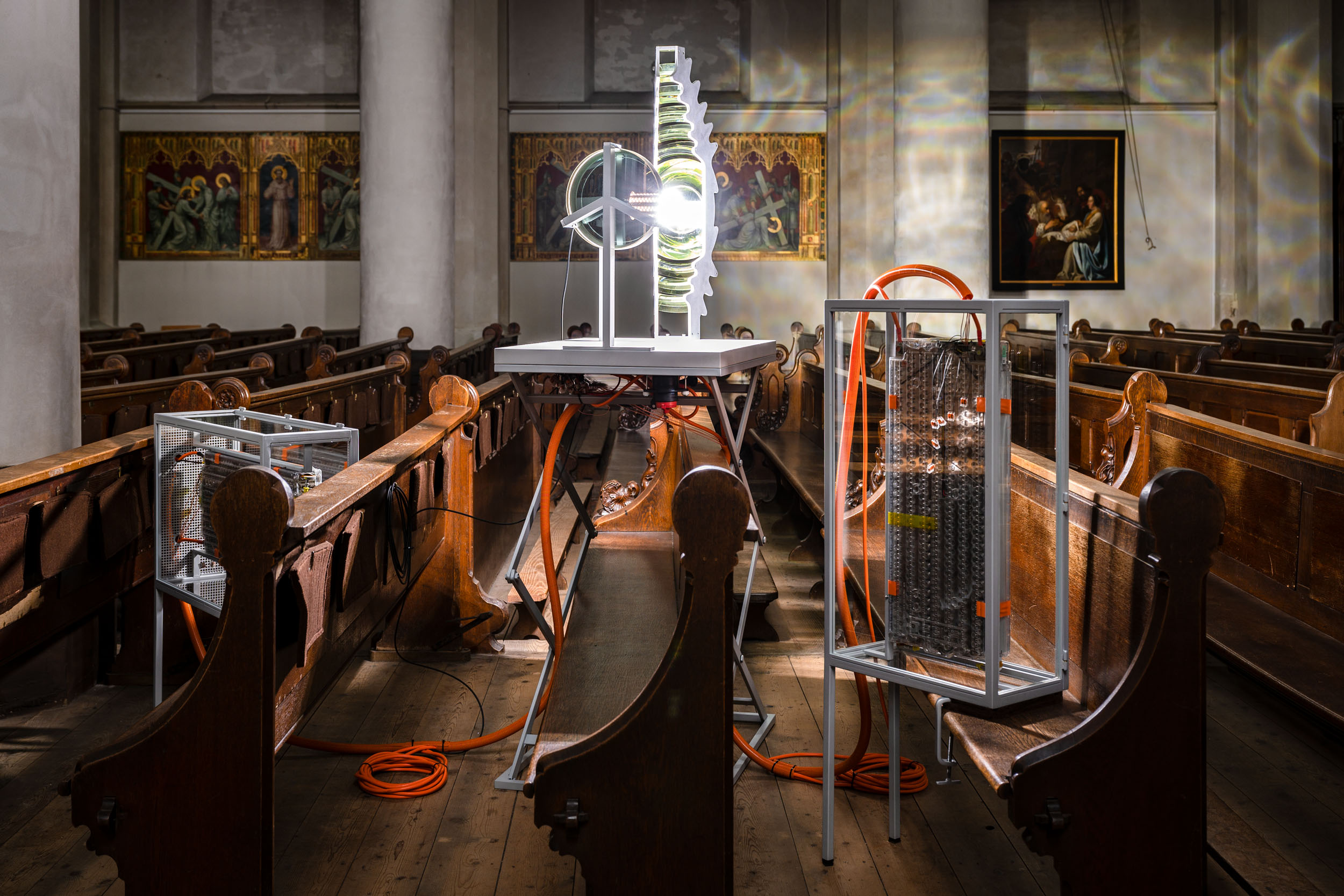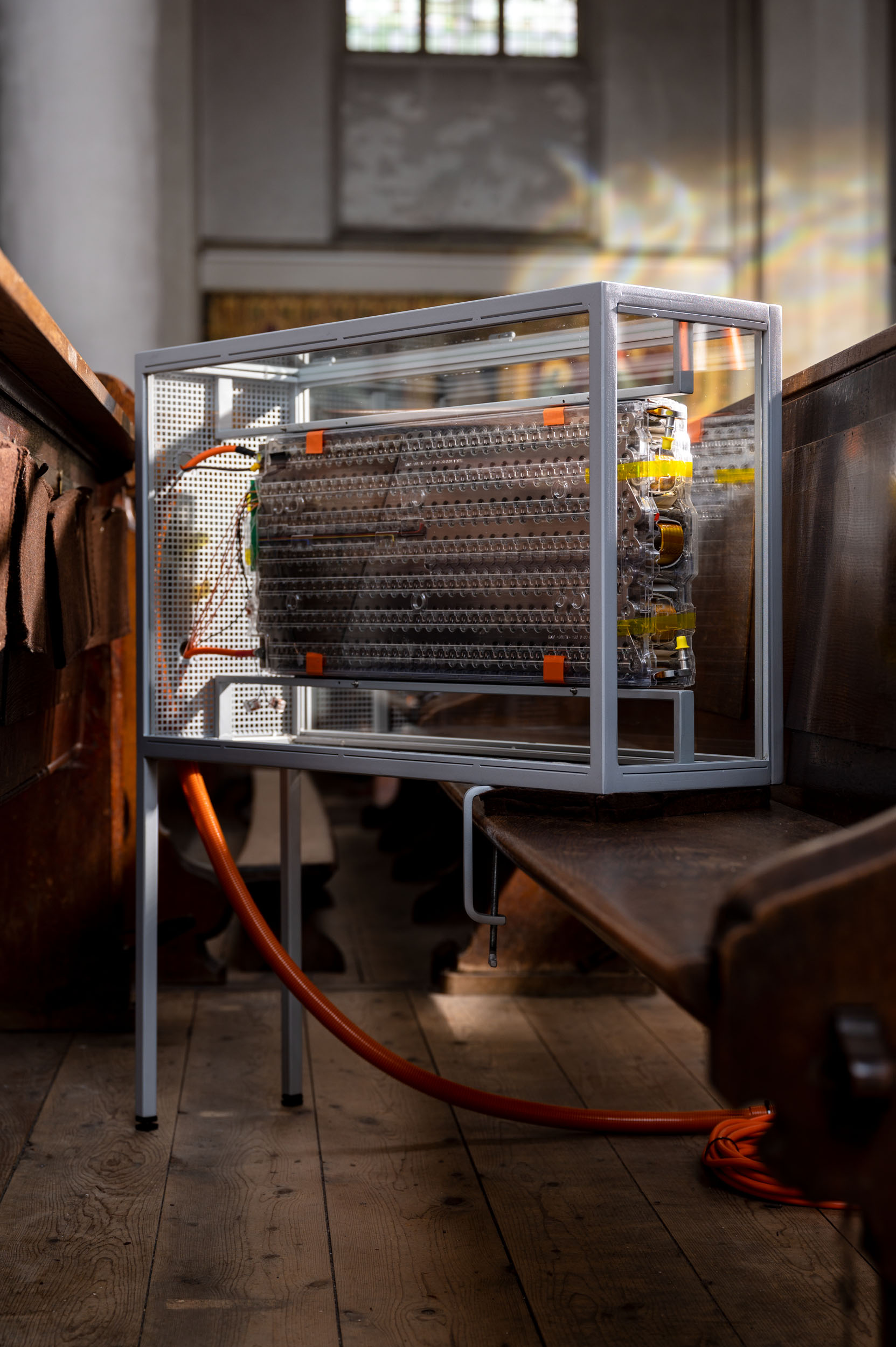Ray
2022
The first cremation in the Netherlands took place at Westerveld in the spring of 1914, after which the ashes of the deceased were scattered ceremonially in the flowering field around the crematorium. The heat produced from the cremation was sent into the sky, unnoticed. Nowadays most funerals in this country are followed by a cremation, with the remaining ashes serving as the substance of commemoration–ashes which have met such heat that not even the traces of DNA linger. While the ashes become an object of remembrance, the surplus heat that remains after the cremation is mostly left outside of consideration.
Ray consists of a single projected beam of light, which slowly searches the space, much like a lighthouse. The battery that generates that light is partly charged with electricity from excess heat that is produced at a crematorium. Developed with consent from living relatives, this reservation and redirection of energy serves as a collective memorial in which commemoration, mourning, and renewal are central.
The project is part of an ongoing research and series of collaborations on energy transference and investigations into how the vitality of matter in decay, remission, or after death can be turned into a power source. Ray proposes ways to experience the heat produced by the process of cremation consciously, to acknowledge the non-linearity of bereavement and loss, and to offer alternate means by which to grieve and remember.
Created especially for the space of St. Catherine’s Cathedral, the artwork is in keeping with its architecture: it encourages quiet contemplation. Ray subtly draws attention to the resonances of death and the challenges of contemporary time-based mourning practices.
2022
The first cremation in the Netherlands took place at Westerveld in the spring of 1914, after which the ashes of the deceased were scattered ceremonially in the flowering field around the crematorium. The heat produced from the cremation was sent into the sky, unnoticed. Nowadays most funerals in this country are followed by a cremation, with the remaining ashes serving as the substance of commemoration–ashes which have met such heat that not even the traces of DNA linger. While the ashes become an object of remembrance, the surplus heat that remains after the cremation is mostly left outside of consideration.
Ray consists of a single projected beam of light, which slowly searches the space, much like a lighthouse. The battery that generates that light is partly charged with electricity from excess heat that is produced at a crematorium. Developed with consent from living relatives, this reservation and redirection of energy serves as a collective memorial in which commemoration, mourning, and renewal are central.
The project is part of an ongoing research and series of collaborations on energy transference and investigations into how the vitality of matter in decay, remission, or after death can be turned into a power source. Ray proposes ways to experience the heat produced by the process of cremation consciously, to acknowledge the non-linearity of bereavement and loss, and to offer alternate means by which to grieve and remember.
Created especially for the space of St. Catherine’s Cathedral, the artwork is in keeping with its architecture: it encourages quiet contemplation. Ray subtly draws attention to the resonances of death and the challenges of contemporary time-based mourning practices.
Light installation. Electricity in part generated from heat produced at a crematorium, lithium batteries, fresnel lens repurposed from a lighthouse, LED-Lamp, concave mirror, powder coated steel and aluminium vitrines and montage.
Ray is commissioned by BAK, basis voor actuele kunst, Utrecht as part of the project ‘No Linear Fucking Time’, realised in collaboration with Museum Catharijneconvent, Utrecht, and housed at St. Catherine’s Cathedral, Utrecht. With thanks to the Catharinaberaad, Sint-Martinusparochie and Diocese of Utrecht.
The ongoing research for Ray is made possible thanks to the generous dialogue and collaboration with funerary expert Babs Bakels, crematory advisers DFW Europe and Hans Struiksma, EV Europe (Peter-Jan Schouten) and Optics Research Group (Thim Zuidwijk), TUDelft. Many thanks also to Tobias Jansen, Pim Kerssemakers, Stef Veldhuis, Mint Park, Niels de Bakker, the wonderful people at BAK (Rachel Rakes, Hidde van Greuningen, Goof Kloosterman) and Rijksakademie staff (Stephan Kuderna, Arend Nijkamp, Kees Reedijk).
Ray is the prototype of an ongoing collaboration witch a crematory near Amsterdam. My deep gratefulness goes outto the meaningful conversations with living relatives and people in the last phase of their live that have contributed to this project.
published writing about Ray: Volkskrant (NL)
photos by Tom Janssen





